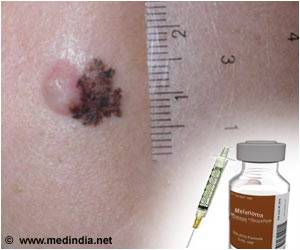Rare mutation of the BRAF gene in people with melanoma has been noted to respond to MEK inhibitor drugs.

Mutations in BRAF V600E or KIT are common in about 40 percent to 50 percent of melanomas, and drugs that block or inhibit BRAF V600E were recently approved for treatment of melanoma patients with these mutations. However, there has been no effective treatment for patients with wildtype (WT) melanoma that is negative for these driver mutations.
To uncover other potentially targetable mutations, the investigators studied the tumor from a 75-year-old patient with an aggressive form of melanoma which was negative for the BRAF V600E mutation. They performed whole genome sequencing on the tumor, along with DNA from matched blood, and confirmed a mutation at BRAF L597.
To determine how many similar mutations might be overlooked by assessing only the BRAF V600 position, they analyzed the mutational status of 49 additional tumor samples negative for V600, as well as recurrent mutations in NRAS and KIT. Two of the tumors (4 percent) were found to have BRAF L597 mutations and a third tumor harbored a BRAF K601E mutation.
BRAF L597 and K601 are adjacent to V600. Since V600 mutants are sensitive to both BRAF and MEK inhibitor drugs, the investigators tested whether the BRAF inhibitor drug vemurafenib and a MEK inhibitor drug could inhibit cell proliferation signals induced by these mutants in cell lines. The MEK inhibitor led to a dramatic shut down of signaling, suggesting that tumors harboring BRAF L597 and K601 mutations might benefit from treatment with MEK inhibitors.
Confirming this hypothesis, a 69-year-old patient with metastatic melanoma harboring a BRAF L597S mutation experienced significant disease shrinkage after two cycles on therapy with a MEK inhibitor drug called TAK-733, currently in Phase I clinical trials. The patient was disease progression-free after more than 24 weeks.
Advertisement
Source-Eurekalert















